the week (or so) in pictures (sort of)
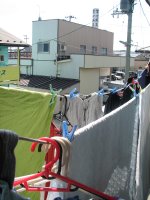 09.15 - Not a pretty picture necessarily, but laundry day at the apartment.
09.15 - Not a pretty picture necessarily, but laundry day at the apartment. 09.16 - Temple in Ishinomaki. Upper right corner: the white things hanging on the tree are folded pieces of paper that contain fortunes. (Outside some temples are boxes like vending machines that one can put money in - usually about 100 yen, the equivilant of about $1 - and get a fortune.) According to TK (my source for all Japan information), some people hang really bad fortunes (as a way of dissiminating the bad fortunate into the big, wide, open universe ) and some hang really good fortunes (as a way of saying thank you and hoping it will come true). The fortunes are on many trees around almost every temple I've seen. (I got a fortune out of a bright red machine outside of Godai-do in Matsushima. Because it was in Japanese, I couldn't read it myself, but, according to TK, it said I didn't have the best fortune, but the second-best. I guess I can live with that. :) )
09.16 - Temple in Ishinomaki. Upper right corner: the white things hanging on the tree are folded pieces of paper that contain fortunes. (Outside some temples are boxes like vending machines that one can put money in - usually about 100 yen, the equivilant of about $1 - and get a fortune.) According to TK (my source for all Japan information), some people hang really bad fortunes (as a way of dissiminating the bad fortunate into the big, wide, open universe ) and some hang really good fortunes (as a way of saying thank you and hoping it will come true). The fortunes are on many trees around almost every temple I've seen. (I got a fortune out of a bright red machine outside of Godai-do in Matsushima. Because it was in Japanese, I couldn't read it myself, but, according to TK, it said I didn't have the best fortune, but the second-best. I guess I can live with that. :) )


 09.19 - Before yochien (kindergarten classes), Mari (right) and I found costumes used at undokai. (Before coming to Japan, I never liked it when people used foreign words when they were writing in English - I found it distracting and not very useful - "If 'yochien' is kindergarten, why do you need to write 'yochien'? The rest of the article isn't in Japanese, why did you feel the need to translate that one word?". Now I understand. The person writing (likely) didn't include the word to be pretentious or becasue they wanted to teach that one word. Likely there was no extra thought into including that foreign word in the text. That's just what the thing is called, and what they're used to calling it. Like you'd call orange juice orange juice (I'm drinking orange juice), you'd call yochien yochien (not "kindergarten") and undokai undokai (not "a sports festival"). Also the big gray object in the forefront of the picture is the CD player on which the song "Hi! How are you? I'm fine" is played (two times every class).
09.19 - Before yochien (kindergarten classes), Mari (right) and I found costumes used at undokai. (Before coming to Japan, I never liked it when people used foreign words when they were writing in English - I found it distracting and not very useful - "If 'yochien' is kindergarten, why do you need to write 'yochien'? The rest of the article isn't in Japanese, why did you feel the need to translate that one word?". Now I understand. The person writing (likely) didn't include the word to be pretentious or becasue they wanted to teach that one word. Likely there was no extra thought into including that foreign word in the text. That's just what the thing is called, and what they're used to calling it. Like you'd call orange juice orange juice (I'm drinking orange juice), you'd call yochien yochien (not "kindergarten") and undokai undokai (not "a sports festival"). Also the big gray object in the forefront of the picture is the CD player on which the song "Hi! How are you? I'm fine" is played (two times every class). 09.20 - Ikebana class. Gyakugatte - one of the basic styles of skin, one of the most elementary forms of ikebana.
09.20 - Ikebana class. Gyakugatte - one of the basic styles of skin, one of the most elementary forms of ikebana. Close up of gyakugatte stems to help me remember...
Close up of gyakugatte stems to help me remember... Hongatte - another basic style of shin (basically gyakugatte reversed)
Hongatte - another basic style of shin (basically gyakugatte reversed)
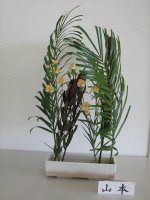 Work by two other women in the class (their last names are printed on the cards in front of their flowers)
Work by two other women in the class (their last names are printed on the cards in front of their flowers)
 09.22 - Walk to work. A sign on the sidewalk encouraging people to look both ways (I think). The Japanese word for frog is kaeru, which also means "to go home" and as a result there are punny signs featuring frogs urging traffic and traveling safety.
09.22 - Walk to work. A sign on the sidewalk encouraging people to look both ways (I think). The Japanese word for frog is kaeru, which also means "to go home" and as a result there are punny signs featuring frogs urging traffic and traveling safety. Glory/celestial shot of the 100 yen ($1) store.
Glory/celestial shot of the 100 yen ($1) store. Following three picture from the green way: a path in the middle of the street for bikers and walkers. Has flowers and miniature water treatments.
Following three picture from the green way: a path in the middle of the street for bikers and walkers. Has flowers and miniature water treatments.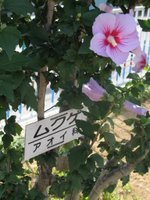

 Tombo, or dragonfly, at the house next door to TK Study Room. The black patches on its wings means autumn is arriving, TK said.
Tombo, or dragonfly, at the house next door to TK Study Room. The black patches on its wings means autumn is arriving, TK said. TK with tombro. He held up his finger and it flew to him.
TK with tombro. He held up his finger and it flew to him. 09.24 - Kenjo-zan (Mount Kenjo). Cups and bottle by a spring on the way up.
09.24 - Kenjo-zan (Mount Kenjo). Cups and bottle by a spring on the way up. Chestnut on the tree. (It's chestnut season.)
Chestnut on the tree. (It's chestnut season.) Ishinomaki as seen from the top of Kenjo-zan.
Ishinomaki as seen from the top of Kenjo-zan. To the east and the Pacific Ocean.
To the east and the Pacific Ocean.

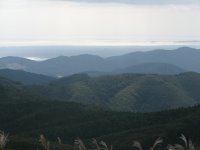
 Shigeko and TK with a man we had lunch with at the top of the mountain. He brought a miniature gas heater and made ramen.
Shigeko and TK with a man we had lunch with at the top of the mountain. He brought a miniature gas heater and made ramen. Rice fields on the way to Kenjo-zan.
Rice fields on the way to Kenjo-zan. Rice harvest in progress.
Rice harvest in progress.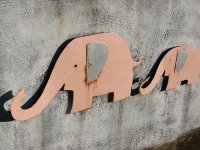 Later 09.24 - Past an elementary school and pink elephants on an evening walk.
Later 09.24 - Past an elementary school and pink elephants on an evening walk. 09.25 - Symmetry: another picture from laundry day. Large spider discovered on balcony when going out to hang out laundry. Spider's current whereabouts: unknown.
09.25 - Symmetry: another picture from laundry day. Large spider discovered on balcony when going out to hang out laundry. Spider's current whereabouts: unknown.
 09.15 - Not a pretty picture necessarily, but laundry day at the apartment.
09.15 - Not a pretty picture necessarily, but laundry day at the apartment. 09.16 - Temple in Ishinomaki. Upper right corner: the white things hanging on the tree are folded pieces of paper that contain fortunes. (Outside some temples are boxes like vending machines that one can put money in - usually about 100 yen, the equivilant of about $1 - and get a fortune.) According to TK (my source for all Japan information), some people hang really bad fortunes (as a way of dissiminating the bad fortunate into the big, wide, open universe ) and some hang really good fortunes (as a way of saying thank you and hoping it will come true). The fortunes are on many trees around almost every temple I've seen. (I got a fortune out of a bright red machine outside of Godai-do in Matsushima. Because it was in Japanese, I couldn't read it myself, but, according to TK, it said I didn't have the best fortune, but the second-best. I guess I can live with that. :) )
09.16 - Temple in Ishinomaki. Upper right corner: the white things hanging on the tree are folded pieces of paper that contain fortunes. (Outside some temples are boxes like vending machines that one can put money in - usually about 100 yen, the equivilant of about $1 - and get a fortune.) According to TK (my source for all Japan information), some people hang really bad fortunes (as a way of dissiminating the bad fortunate into the big, wide, open universe ) and some hang really good fortunes (as a way of saying thank you and hoping it will come true). The fortunes are on many trees around almost every temple I've seen. (I got a fortune out of a bright red machine outside of Godai-do in Matsushima. Because it was in Japanese, I couldn't read it myself, but, according to TK, it said I didn't have the best fortune, but the second-best. I guess I can live with that. :) )


 09.19 - Before yochien (kindergarten classes), Mari (right) and I found costumes used at undokai. (Before coming to Japan, I never liked it when people used foreign words when they were writing in English - I found it distracting and not very useful - "If 'yochien' is kindergarten, why do you need to write 'yochien'? The rest of the article isn't in Japanese, why did you feel the need to translate that one word?". Now I understand. The person writing (likely) didn't include the word to be pretentious or becasue they wanted to teach that one word. Likely there was no extra thought into including that foreign word in the text. That's just what the thing is called, and what they're used to calling it. Like you'd call orange juice orange juice (I'm drinking orange juice), you'd call yochien yochien (not "kindergarten") and undokai undokai (not "a sports festival"). Also the big gray object in the forefront of the picture is the CD player on which the song "Hi! How are you? I'm fine" is played (two times every class).
09.19 - Before yochien (kindergarten classes), Mari (right) and I found costumes used at undokai. (Before coming to Japan, I never liked it when people used foreign words when they were writing in English - I found it distracting and not very useful - "If 'yochien' is kindergarten, why do you need to write 'yochien'? The rest of the article isn't in Japanese, why did you feel the need to translate that one word?". Now I understand. The person writing (likely) didn't include the word to be pretentious or becasue they wanted to teach that one word. Likely there was no extra thought into including that foreign word in the text. That's just what the thing is called, and what they're used to calling it. Like you'd call orange juice orange juice (I'm drinking orange juice), you'd call yochien yochien (not "kindergarten") and undokai undokai (not "a sports festival"). Also the big gray object in the forefront of the picture is the CD player on which the song "Hi! How are you? I'm fine" is played (two times every class). 09.20 - Ikebana class. Gyakugatte - one of the basic styles of skin, one of the most elementary forms of ikebana.
09.20 - Ikebana class. Gyakugatte - one of the basic styles of skin, one of the most elementary forms of ikebana. Close up of gyakugatte stems to help me remember...
Close up of gyakugatte stems to help me remember... Hongatte - another basic style of shin (basically gyakugatte reversed)
Hongatte - another basic style of shin (basically gyakugatte reversed)
 Work by two other women in the class (their last names are printed on the cards in front of their flowers)
Work by two other women in the class (their last names are printed on the cards in front of their flowers) 09.22 - Walk to work. A sign on the sidewalk encouraging people to look both ways (I think). The Japanese word for frog is kaeru, which also means "to go home" and as a result there are punny signs featuring frogs urging traffic and traveling safety.
09.22 - Walk to work. A sign on the sidewalk encouraging people to look both ways (I think). The Japanese word for frog is kaeru, which also means "to go home" and as a result there are punny signs featuring frogs urging traffic and traveling safety. Glory/celestial shot of the 100 yen ($1) store.
Glory/celestial shot of the 100 yen ($1) store. Following three picture from the green way: a path in the middle of the street for bikers and walkers. Has flowers and miniature water treatments.
Following three picture from the green way: a path in the middle of the street for bikers and walkers. Has flowers and miniature water treatments.

 Tombo, or dragonfly, at the house next door to TK Study Room. The black patches on its wings means autumn is arriving, TK said.
Tombo, or dragonfly, at the house next door to TK Study Room. The black patches on its wings means autumn is arriving, TK said. TK with tombro. He held up his finger and it flew to him.
TK with tombro. He held up his finger and it flew to him. 09.24 - Kenjo-zan (Mount Kenjo). Cups and bottle by a spring on the way up.
09.24 - Kenjo-zan (Mount Kenjo). Cups and bottle by a spring on the way up. Chestnut on the tree. (It's chestnut season.)
Chestnut on the tree. (It's chestnut season.) Ishinomaki as seen from the top of Kenjo-zan.
Ishinomaki as seen from the top of Kenjo-zan. To the east and the Pacific Ocean.
To the east and the Pacific Ocean.


 Shigeko and TK with a man we had lunch with at the top of the mountain. He brought a miniature gas heater and made ramen.
Shigeko and TK with a man we had lunch with at the top of the mountain. He brought a miniature gas heater and made ramen. Rice fields on the way to Kenjo-zan.
Rice fields on the way to Kenjo-zan. Rice harvest in progress.
Rice harvest in progress. Later 09.24 - Past an elementary school and pink elephants on an evening walk.
Later 09.24 - Past an elementary school and pink elephants on an evening walk. 09.25 - Symmetry: another picture from laundry day. Large spider discovered on balcony when going out to hang out laundry. Spider's current whereabouts: unknown.
09.25 - Symmetry: another picture from laundry day. Large spider discovered on balcony when going out to hang out laundry. Spider's current whereabouts: unknown.


0 Comments:
Post a Comment
<< Home